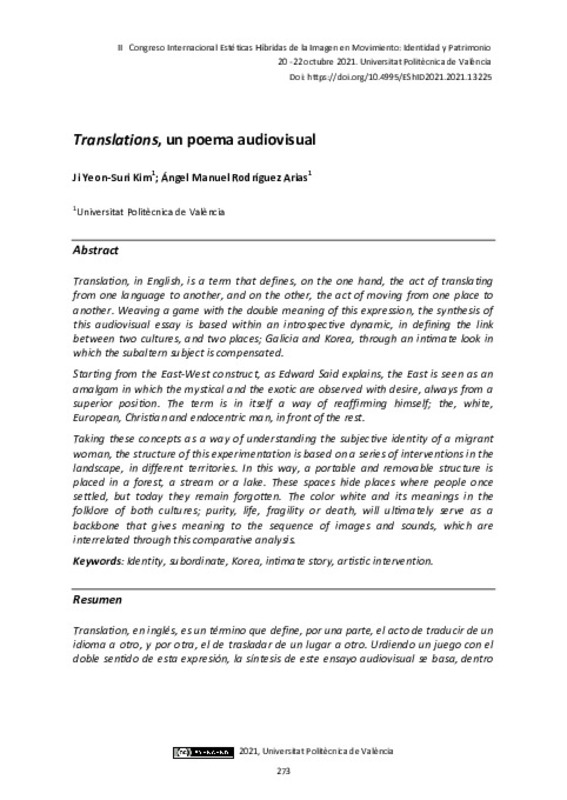|
Resumen:
|
[EN] Translation, in English, is a term that defines, on the one hand, the act of translating
from one language to another, and on the other, the act of moving from one place to
another. Weaving a game with the double ...[+]
[EN] Translation, in English, is a term that defines, on the one hand, the act of translating
from one language to another, and on the other, the act of moving from one place to
another. Weaving a game with the double meaning of this expression, the synthesis of
this audiovisual essay is based within an introspective dynamic, in defining the link
between two cultures, and two places; Galicia and Korea, through an intimate look in
which the subaltern subject is compensated.
Starting from the East-West construct, as Edward Said explains, the East is seen as an
amalgam in which the mystical and the exotic are observed with desire, always from a
superior position. The term is in itself a way of reaffirming himself; the, white,
European, Christian and endocentric man, in front of the rest.
Taking these concepts as a way of understanding the subjective identity of a migrant
woman, the structure of this experimentation is based on a series of interventions in the
landscape, in different territories. In this way, a portable and removable structure is
placed in a forest, a stream or a lake. These spaces hide places where people once
settled, but today they remain forgotten. The color white and its meanings in the
folklore of both cultures; purity, life, fragility or death, will ultimately serve as a
backbone that gives meaning to the sequence of images and sounds, which are
interrelated through this comparative analysis.
[-]
[ES] Translation, en inglés, es un término que define, por una parte, el acto de traducir de un idioma a otro, y por otra, el de trasladar de un lugar a otro. Urdiendo un juego con el doble sentido de esta expresión, la ...[+]
[ES] Translation, en inglés, es un término que define, por una parte, el acto de traducir de un idioma a otro, y por otra, el de trasladar de un lugar a otro. Urdiendo un juego con el doble sentido de esta expresión, la síntesis de este ensayo audiovisual se basa dentro de una dinámica introspectiva, en definir el vínculo entre dos culturas, y dos lugares; Galicia y Corea, a través de una mirada íntima en la que se resarza al sujeto subalterno. Partiendo del constructo Oriente-Occidente, como explica Edward Saíd, el primero es visto como un amalgama en el que lo místico y lo exótico se observan con deseo, siempre desde una posición superior. El término se trata en sí mismo de una forma de reafirmarse a sí mismo; al hombre, blanco, europeo, cristiano y endocéntrico, frente al resto. En consecuencia, tomando estos conceptos como una forma de comprender la propia identidad subjetiva de una mujer migrante, la estructura de esta experimentación se basa en una serie de intervenciones en el paisaje, en distintos territorios. De este modo, una estructura portátil y desmontable es colocada en un bosque, un arroyo o un lago. Estos espacios, esconden lugares en los que las personas se asentaron antaño, pero hoy permanecen olvidados. El color blanco y sus significaciones en el folclore de ambas culturas; pureza, vida, fragilidad o muerte, servirán, en definitiva, de elemento vertebrador que da sentido a la secuencia de imágenes y sonidos, las cuales se interrelacionan a través de este análisis comparativo.
[-]
|









